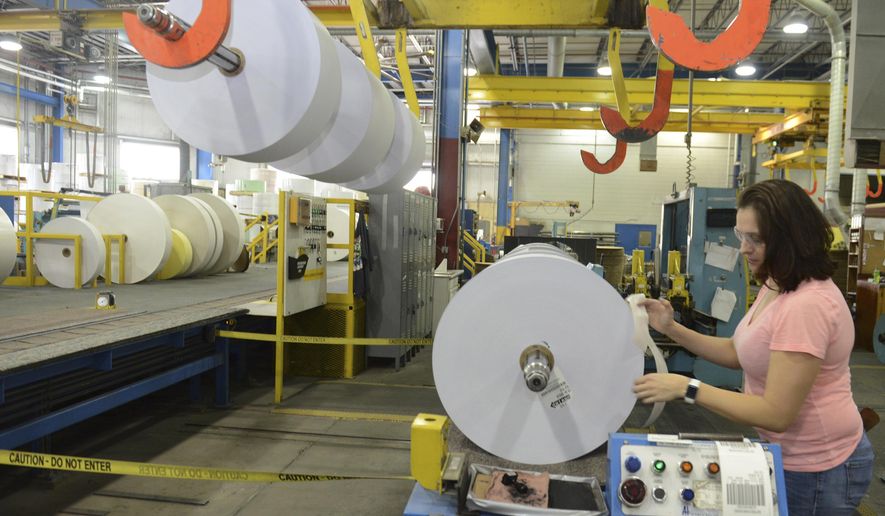ALTOONA, Pa. (AP) - Approach nearly any small town in central Pennsylvania and you’re likely to see one of two things.
If the town is lucky - like Roaring Spring or Tyrone - you will see plumes of steam and full parking lots at an industrial landmark. If it’s not - as in Saxton in recent years - you will see a shuttered factory, “for sale” signs and all the attendant markers of a town whose industry has died.
The story of the Rust Belt, the wide expanse of Great Lakes and Midwestern cities, is one of decades-long manufacturing decline. But while the Rust Belt’s large and medium-sized cities have often managed to claw their way back to a growing economy, small towns with just one or two employers can remain desolate for decades.
The paths they have taken to survive and grow can serve as examples for those still reeling in a post-industrial era. Some have preserved their old industries in a smaller, more high-tech form; others have shifted gears completely.
And some remain seemingly unable to recover.
“It’s almost kind of a spiritual thing,” said Saxton Mayor Alan Smith, whose Bedford County town lost its largest employer, a car upholstery manufacturer, about nine years ago. Today, Saxton is looking to the medical marijuana industry to restore at least a fraction of its old jobs.
“People are always thinking about restoration, restoration to a time when you look back and say, ‘These were good times,’” Smith said. “Quality of life in small towns had value.”
Gradual decline
The loss of industry in northeastern and midwestern towns is often demonstrated visually: huge, empty steel mills and shipyards in cities like Pittsburgh, Philadelphia and Detroit. But many of the changes have hit smaller towns with just a few thousand people, often many miles from metropolitan areas.
In the decades after the 1950s, dozens of Pennsylvania counties not touching Pittsburgh and Philadelphia lost manufacturing work with many shedding more than half their manufacturing jobs by the early 21st century.
During the first 13 years of the century, non-metropolitan counties nationwide grew far more slowly than large and small cities - with rural areas shrinking overall for several of those years.
“At this point, the prognosis does not look good for much of small town America,” researchers for the Brookings Institution wrote in 2014. “As badly as some regions have fared during the post-recession period, the new statistics show population decline in smaller areas, increasing large metropolitan area dominance.”
Since 2001, Pennsylvania in total has lost 300,000 manufacturing jobs - 34 percent of its base, according to the Bureau of Labor Statistics.
The decline hit different towns at different times, but the story is often similar. A major factory or cluster of factories closes or shrinks as jobs are automated or sent overseas. In some cases, another business takes their place for a time, but rarely equals its predecessor.
Claysburg lost most of its refractories - mills that produced silica bricks used in steel production - gradually by the 1980s. Mount Union followed the same path, its population declining from nearly 5,000 in 1930 to less than 2,400 today.
Williamsburg’s Westvaco paper mill closed in the 1970s. Saxton lost its coal industry, then its power plants and finally its Seton Co. upholstery factory over a period of decades.
And a slew of small coal towns in Cambria County and the Broad Top area, many founded by companies for a single purpose, have been left without their original industries for decades.
“It’s just been kind of a steady exodus of sustaining jobs that have jumped ship and gone down south,” said Bob Kutz, president of the Blair-Bedford Central Labor Council. “There doesn’t seem to be any magic bullet for all these spots that were once there.”
That can lead to not only a depressed economy, but a demoralized populace.
‘Not a good way to live’
A single large factory or power plant could once sustain not only hundreds of well-paying jobs, but an entire economy, Smith of Saxton said.
“Communities that at one time were almost self-contained communities that had furniture stores, men’s clothing stores, women’s clothing stories, butcher shops, hardware stores where you could find anything, theaters - that all had disappeared,” he said. “People remember those days when you used to go to Mount Union and shop in these exclusive men’s and women’s clothing stores. Those days are gone.”
Saxton went through several industries, eventually settling in with the upholstery factory that employed some 1,200 people by the early 2000s. When the plant closed, the town was left without its signature business.
Store closures followed, along with local ripples of the nationwide opioid crisis, Smith said. In many communities like Saxton, an aging population and a waning community spirit meant less interest in clubs, churches and children’s sports.
“When there is not the prospect or opportunity for meaningful employment, which in turn means families and home ownership, I think it creates a sense of despair and some degree of hopelessness,” he said.
In Claysburg, the decline of silica bricks was years in the making as steel waned across the country, said Rich Allison, a community activist and historian who once was president of General Refractories. The mills closed for months at a time, leaving workers without the security they’d once enjoyed.
“The brickyard was very cyclical at the time. You’d get a huge order and it might go for a year and a half, and then you might have everyone laid off for six months, nine months, a year,” Allison said. “That was not a good way to live, even if they paid exceptionally good wages at the time.”
One refractory remains in neighboring Sproul with about 80 workers, he said. But that’s a fraction of the industry’s strength at its height.
Not every small town took those hits, however. And some that did managed to survive by other means - in some cases fighting to keep their factories or bring them back into operation within a few years.
Reopening and automation
When Westvaco closed its Tyrone paper mill’s doors on Oct. 26, 2001, local leaders didn’t know what to do.
The closure shed 265 jobs and left a sprawling industrial center closed, but officials weren’t even certain the site would be put up for sale, according to Mirror interviews at the time.
Two years later, a group of area business figures and investors united to buy the property and reopen the site under a new name: American Eagle Paper Mills. Today, according to company literature, the mill employs about 240 people - fewer than at its height, but a sizable economic force for a town of a few thousand.
At the other end of Blair County, Roaring Spring has long relied on paper as its sustaining industry. The borough’s history has been intertwined with Roaring Spring Blank Book Co. since 1887, and the nearby Appvion paper mill’s smokestacks are recognizable from any direction.
When the mill’s France-based owners announced plans to sell their American subsidiary, Appleton Papers, in 2001, workers in towns like Roaring Spring were left at risk. But employees across the country pitched in to take control of the company, forming a worker-owned corporation - now called Appvion Inc. - that still operates the plant today.
In Bedford, bicycle manufacturer Cannondale announced plans in 2009 to close a facility and lay off hundreds of employees as work moved overseas. Officials in Bedford County managed to lure new manufacturers and high-tech businesses to county parks in recent years, maintaining an industrial base along the highways that pass the borough.
Not every town has been so lucky, however.
In many cases, there is little hope of preserving a local industry. Instead, local leaders have to branch out into unfamiliar new fields in hopes of weathering change.
That’s what officials have attempted in Mount Union. Once a thriving silica center nicknamed “Bricktown,” the town lost its industry and the bulk of its population in the same downturn that struck Claysburg.
Since then - with involvement and county business agencies - the borough has secured new, high-tech industry, said Bob Reitman, executive director of Huntingdon County Business & Industry. Reitman pointed to companies like ACProducts Inc., which operates a cabinet factory in the town.
“They are a cabinet factory that’s very efficient,” Reitman said. “It’s highly automated. They can put different faces and different hardware and different materials in there very quickly. I’ve never seen as much automation in a woodworking business.”
Locals and workers welcome any new business, but automation often means new industries employ far fewer locals than their predecessors.
Reitman said county officials have filled a business park near Huntingdon and are still working to revitalize Mount Union’s business district. But where larger cities like Altoona can rely on booming fields like medicine and education, those like Mount Union don’t often have as many options.
‘Even 25 jobs’
Claysburg has managed to climb back from its silica brick decline with a collection of other industries.
NPC Inc., a print and digital company that distributes communication materials, is a community fixture, as is Shirley’s Cookie Co., an industrial-scale dessert producer.
But Claysburg’s fastest-growing employer is likely Sheetz Inc., which has established an office complex, distribution center and employee wellness building in the community. As of a couple of years ago, Allison said, Sheetz employed some 1,200 people in Claysburg - a number that keeps growing as the company establishes new operations there.
“A lot of it is luck. You don’t know who you’re pulling in,” he said. “You’re never done, but absolutely, Claysburg is probably one of the best success stories for bringing business in in the whole central Pennsylvania area.”
It’s not simply a matter of convincing new industries and companies to move into a post-industrial town, said Steve McKnight, president and CEO of the Altoona-Blair County Development Corp., which controls several business parks across the county.
“When you’re looking at a true single-industry town, where say, more than half of your employment base rested on a single company - a U.S. Steel or a Pennsylvania Railroad - it’s going to take a long time to diversify. And it’s definitely going to take a long time for a community to culturally change.”
McKnight said the broad trend today is for more a diverse, broad industry spread across a city or town. Visitors might not see a single towering mill or factory anymore, he said, but a collection of less noticeable companies can still operate across a community.
For those that have not yet got those industries, an aging population with pensions, Social Security payments and property can buy some time and support an economy, said Smith of Saxton. But sooner a later, a town needs a new industry.
In Saxton, that could soon be medical marijuana as Maryland-based Green Leaf Medical LLC finalizes a deal to take over the shuttered Seton plant.
The company’s director said he would first hire only 15 or 20 employees if it gets a state license to grow the plant - a tiny fraction of the jobs the building once supported. But officials hope the operation would grow, eventually inspiring other businesses to rent space in the sprawling former factory.
For small towns, hope for the future can be an important resource in itself, Smith said.
“This does bring a sense of hope. You have a deteriorating factory that at some point was going to have no value. Now it may be the key to beginning some revitalization and renewal,” he said. “Even 25 jobs or maybe the potential for 100 jobs - it shows how valuable that is, how uplifting.”
___
Online:
https://bit.ly/2pvmg7v
___
Information from: Altoona Mirror, https://www.altoonamirror.com




Please read our comment policy before commenting.